A Simulator for Investigation of Breakdown Characteristics of SiC MOSFETs
Abstract
1. Introduction
2. Simulation Method and Validation
2.1. Simulation Method
2.2. Validation
3. Results and Discussion
3.1. Analysis of the Lattice Temperature
3.2. Evaluation of the Device Geometry
3.3. Evaluation of the Doping Profile
4. Conclusions
Author Contributions
Funding
Institutional Review Board Statement
Informed Consent Statement
Data Availability Statement
Conflicts of Interest
References
- Millan, J.; Godignon, P.; Perpiñà, X.; Pérez-Tomás, A.; Rebollo, J. A Survey of Wide Bandgap Power Semiconductor Devices. IEEE Trans. Power Electron. 2013, 29, 2155–2163. [Google Scholar] [CrossRef]
- Kimoto, T.; Watanabe, H. Defect Engineering in SiC Technology for High-Voltage Power Devices. Appl. Phys. Express 2020, 13, 120101. [Google Scholar] [CrossRef]
- Iwamuro, N. Recent Progress of SiC-MOSFETs and Their Futures-Competion with State-of-the-Art Si-IGBT-. In Proceedings of the 2019 International Conference on Electronics Packaging (ICEP), Niigata, Japan, 17–20 April 2019. [Google Scholar]
- Langpoklakpam, C.; Liu, A.-C.; Chu, K.-H.; Hsu, L.-H.; Lee, W.-C.; Chen, S.-C.; Sun, C.-W.; Shih, M.-H.; Lee, K.-Y.; Kuo, H.-C. Review of Silicon Carbide Processing for Power MOSFET. Crystals 2022, 12, 245. [Google Scholar] [CrossRef]
- Cooper, J.A.; Agarwal, A. SiC Power-Switching Devices-the Second Electronics Revolution? Proc. IEEE 2002, 90, 956–968. [Google Scholar] [CrossRef]
- Kimoto, T. Material Science and Device Physics in SiC Technology for High-Voltage Power Devices. Jpn. J. Appl. Phys. 2015, 54, 040103. [Google Scholar] [CrossRef]
- Zeng, Z.; Zhang, X.; Blaabjerg, F.; Miao, L. Impedance-Oriented Transient Instability Modeling of SiC Mosfet Intruded by Measurement Probes. IEEE Trans. Power Electron. 2020, 35, 1866–1881. [Google Scholar] [CrossRef]
- Talesara, V.; Xing, D.; Fang, X.; Fu, L.; Shao, Y.; Wang, J.; Lu, W. Dynamic Switching of SiC Power MOSFETs Based on Analytical Subcircuit Model. IEEE Trans. Power Electron. 2020, 35, 9680–9689. [Google Scholar] [CrossRef]
- Baliga, B.J. Silicon Carbide Power Devices. In Springer Handbook of Semiconductor Devices; Rudan, M., Brunetti, R., Reggiani, S., Eds.; Springer Handbooks; Springer International Publishing: New York, NY, USA, 2023; pp. 491–523. [Google Scholar]
- Zhang, R.; Zhang, Y. Power Device Breakdown Mechanism and Characterization: Review and Perspective. Jpn. J. Appl. Phys. 2023, 62, SC0806. [Google Scholar] [CrossRef]
- Kimoto, T. Wide Bandgap Semiconductor Power Devices; Woodhead Publishing Series in Electronic and Optical Materials; Woodhead Publishing: Cambridge, UK, 2019; pp. 21–42. [Google Scholar]
- Pocaterra, M.; Ciappa, M. TCAD Investigation of the Transport of Carriers Deposited by Alpha Particles in Silicon Carbide Power Schottky Devices. Microelectron. Reliab. 2021, 126, 114317. [Google Scholar] [CrossRef]
- Bank, R.E.; Rose, D.J.; Fichtner, W. Numerical Methods for Semiconductor Device Simulation. SIAM J. Sci. Stat. Comput. 1983, 4, 416–435. [Google Scholar] [CrossRef]
- Selberherr, S. Analysis and Simulation of Semiconductor Devices; Springer International Publishing: New York, NY, USA, 1984. [Google Scholar]
- Price, C.H. Two-Dimensional Numerical Simulation of Semiconductor Devices. Ph.D. Thesis, Stanford University, Stanford, CA, USA, 1982. [Google Scholar]
- Pinto, M.R. Comprehensive Semiconductor Device Simulation for Silicon ULSI. Ph.D. Thesis, Stanford University, Stanford, CA, USA, 1990. [Google Scholar]
- Forghieri, A.; Guerrieri, R.; Ciampolini, P.; Gnudi, A.; Rudan, M.; Baccarani, G. A New Discretization Strategy of the Semiconductor Equations Comprising Momentum and Energy Balance. IEEE Trans. Comput. Aided Des. Integr. Circuits Syst. 1988, 7, 231–242. [Google Scholar] [CrossRef]
- Choi, W.-S.; Ahn, J.-G.; Park, Y.-J.; Min, H.-S.; Hwang, C.-G. A Time Dependent Hydrodynamic Device Simulator SNU-2D with New Discretization Scheme and Algorithm. IEEE Trans. Comput. Aided Des. Integr. Circuits Syst. 1994, 13, 899–908. [Google Scholar] [CrossRef]
- Scharfetter, D.L.; Gummel, H.K. Large-Signal Analysis of a Silicon Read Diode Oscillator. IEEE Trans. Electron. Devices 1969, 16, 64–77. [Google Scholar] [CrossRef]
- PETSc Manual. Available online: https://petsc.org/release/manual/ (accessed on 10 October 2021).
- Roschke, M.; Schwierz, F. Electron Mobility Models for 4H, 6H, and 3C SiC [MESFETs]. IEEE Trans. Electron. Devices 2001, 48, 1442–1447. [Google Scholar] [CrossRef]
- Masetti, G.; Severi, M.; Solmi, S. Modeling of Carrier Mobility against Carrier Concentration in Arsenic-, Phosphorus-, and Boron-Doped Silicon. IEEE Trans. Electron. Devices. 1983, 30, 764–769. [Google Scholar] [CrossRef]
- Lombardi, C.; Manzini, S.; Saporito, A.; Vanzi, M. A Physically Based Mobility Model for Numerical Simulation of Nonplanar Devices. IEEE Trans. Comput. Aided Des. Integr. Circuits Syst. 1988, 7, 1164–1171. [Google Scholar] [CrossRef]
- Noguchi, M.; Iwamatsu, T.; Amishiro, H.; Watanabe, H.; Kita, K.; Yamakawa, S. Determination of Intrinsic Phonon-Limited Mobility and Carrier Transport Property Extraction of 4H-SiC MOSFETs. In Proceedings of the 2017 IEEE International Electron Devices Meeting (IEDM), San Francisco, CA, USA, 2–6 December 2017. [Google Scholar]
- Linewih, H.; Dimitrijev, S. Channel-Carrier Mobility Parameters for 4H SiC MOSFETs. In Proceedings of the 2002 23rd International Conference on Microelectronics, Nis, Serbia, 12–15 May 2002. [Google Scholar]
- Khan, I.A.; Cooper, J.A. Measurement of High-Field Electron Transport in Silicon Carbide. IEEE Trans. Electron. Devices. 2000, 47, 269–273. [Google Scholar] [CrossRef]
- Canali, C.; Majni, G.; Minder, R.; Ottaviani, G. Electron and Hole Drift Velocity Measurements in Silicon and Their Empirical Relation to Electric Field and Temperature. IEEE Trans. Electron. Devices 1975, 22, 1045–1047. [Google Scholar] [CrossRef]
- Galeckas, A.; Linnros, J.; Grivickas, V.; Lindefelt, U.; Hallin, C. Auger Recombination in 4H-SiC: Unusual Temperature Behavior. Appl. Phys. Lett. 1997, 71, 3269–3271. [Google Scholar] [CrossRef]
- Shockley, W.; Read, W.T. Statistics of the Recombinations of Holes and Electrons. Phys. Rev. 1952, 87, 835–842. [Google Scholar] [CrossRef]
- Van Overstraeten, R.; De Man, H. Measurement of the Ionization Rates in Diffused Silicon Pn Junctions. Solid-State Electron. 1970, 13, 583–608. [Google Scholar] [CrossRef]
- Matsuura, H. Influence of Excited States of Deep Acceptors on Hole Concentrations in SiC. Mater. Sci. Forum. 2002, 389, 679–682. [Google Scholar] [CrossRef]
- Lades, M. Modeling and Simulation of Wide Bandgap Semiconductor Devices. Ph.D. Thesis, Technische Universität München, München, Germany, 2000. [Google Scholar]
- Alqaysi, M.H.; Martinez, A.; Ahmeda, K.; Ubochi, B.; Kalna, K. Impact of Interface Traps/Defects and Self-heating on the Degradation of Performance of a 4H-SiC VDMOSFET. IET Power Electron. 2019, 12, 2731–2740. [Google Scholar] [CrossRef]
- CREE Model C2M1000170D 2015. Available online: http://www.cree.com/media/Files/Cree/Power/Data20Sheets/C2M1000170D.pdf (accessed on 29 March 2023).
- TCAD Sentaurus Device Manual; Synopsys: Sunnyvale, CA, USA, 2020.
- Baliga, B.J. Power Semiconductor Device Figure of Merit for High-Frequency Applications. IEEE Electron. Device Lett. 1989, 10, 455–457. [Google Scholar] [CrossRef]
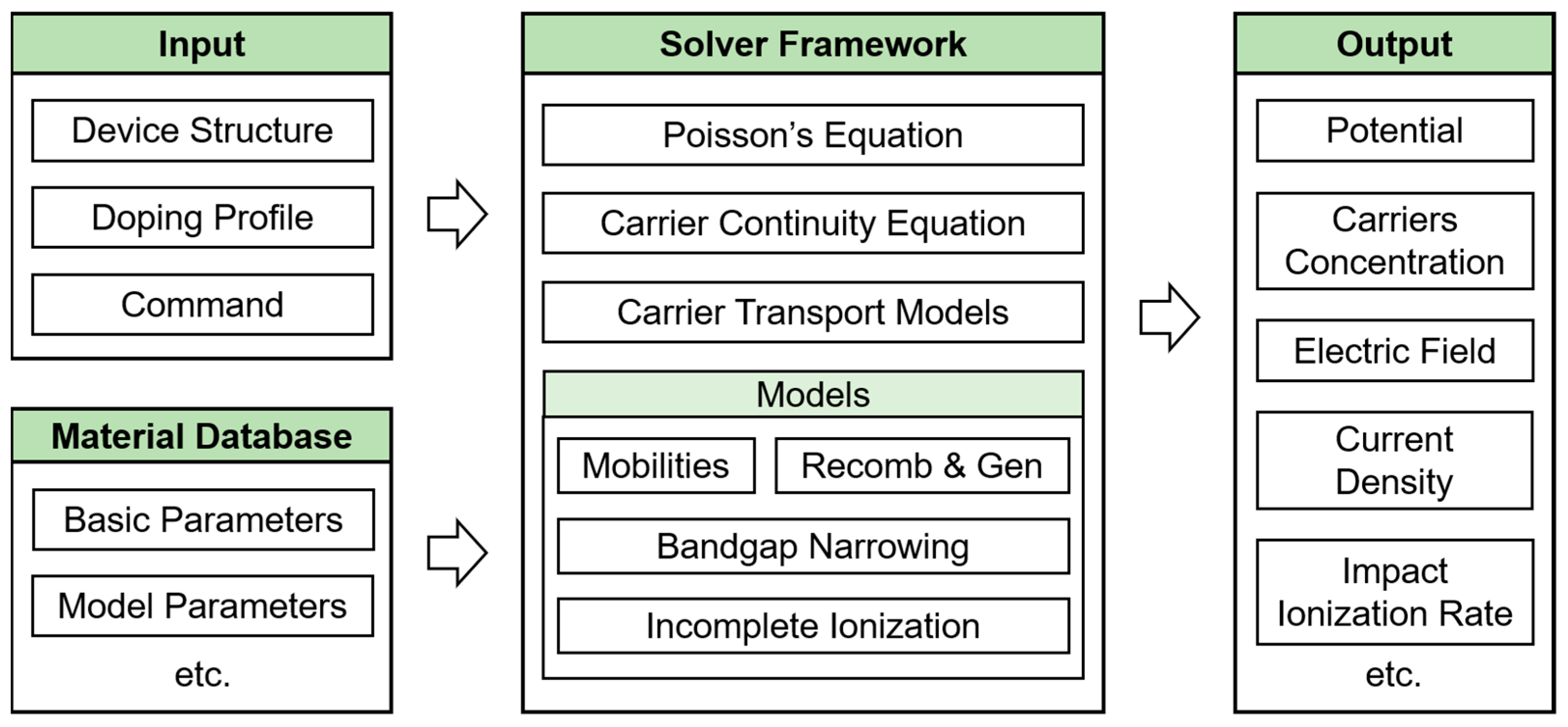
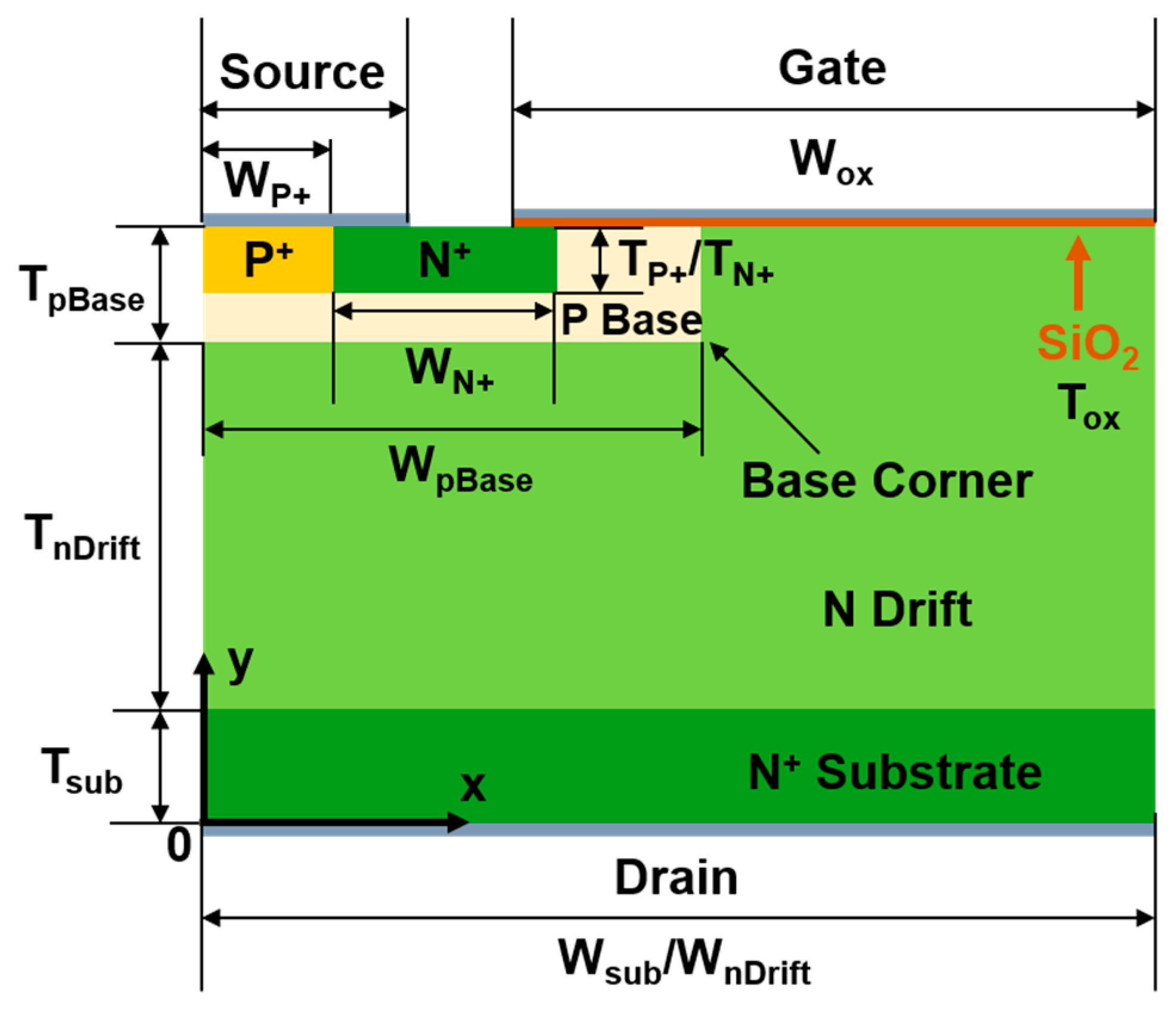

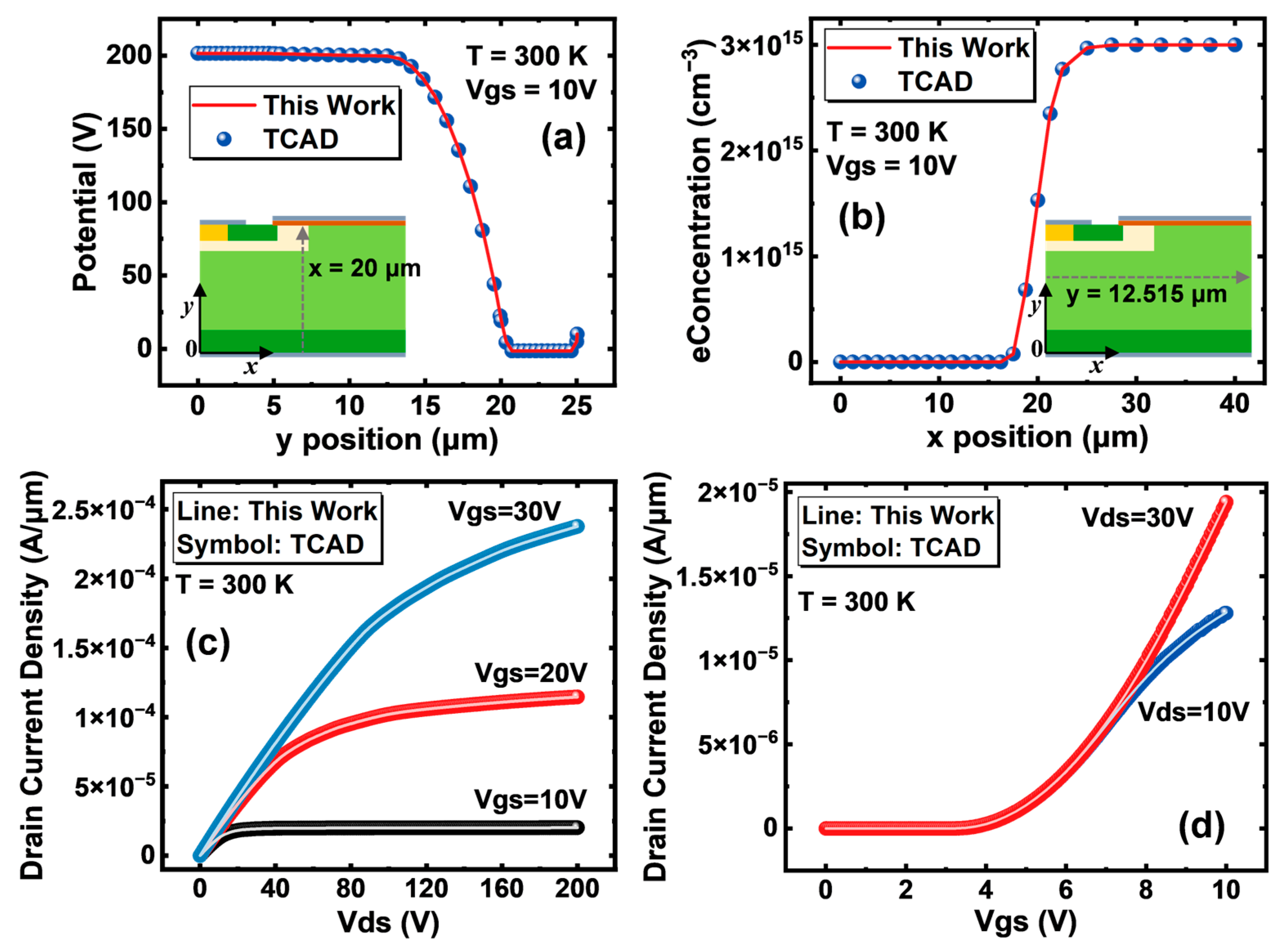
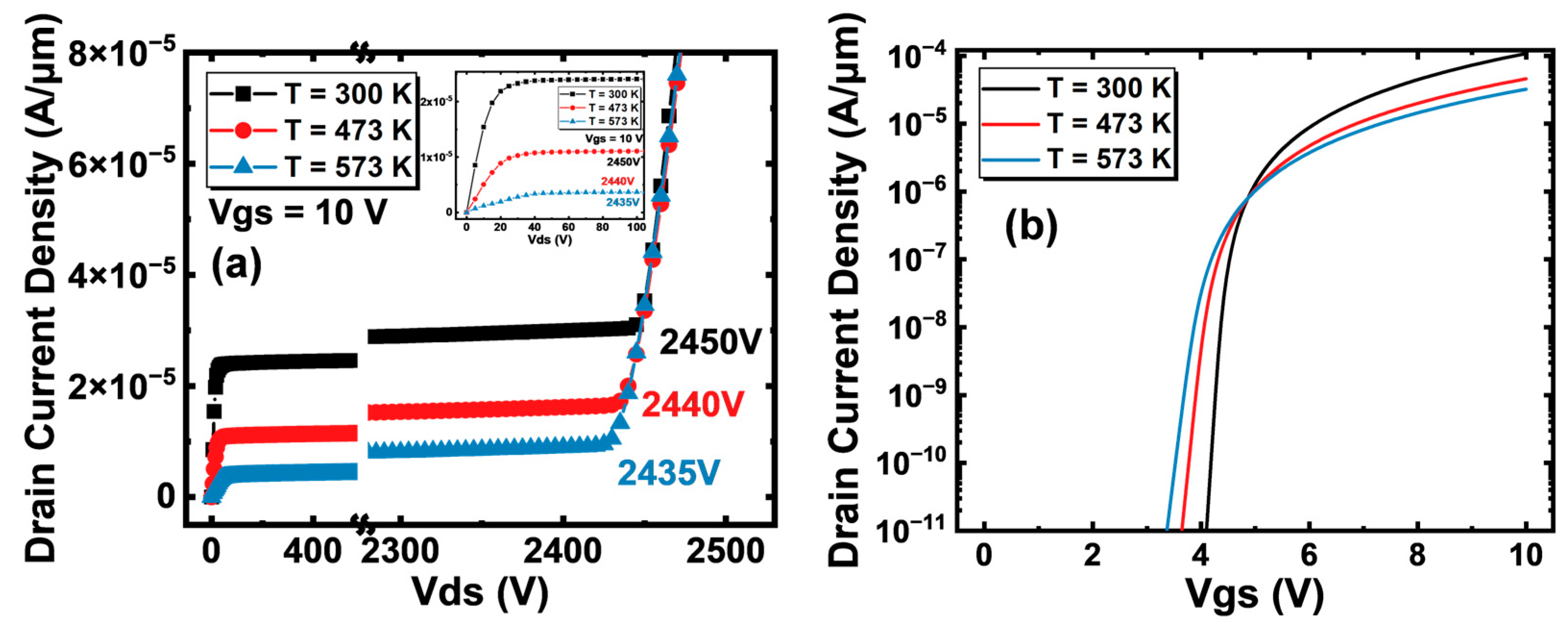

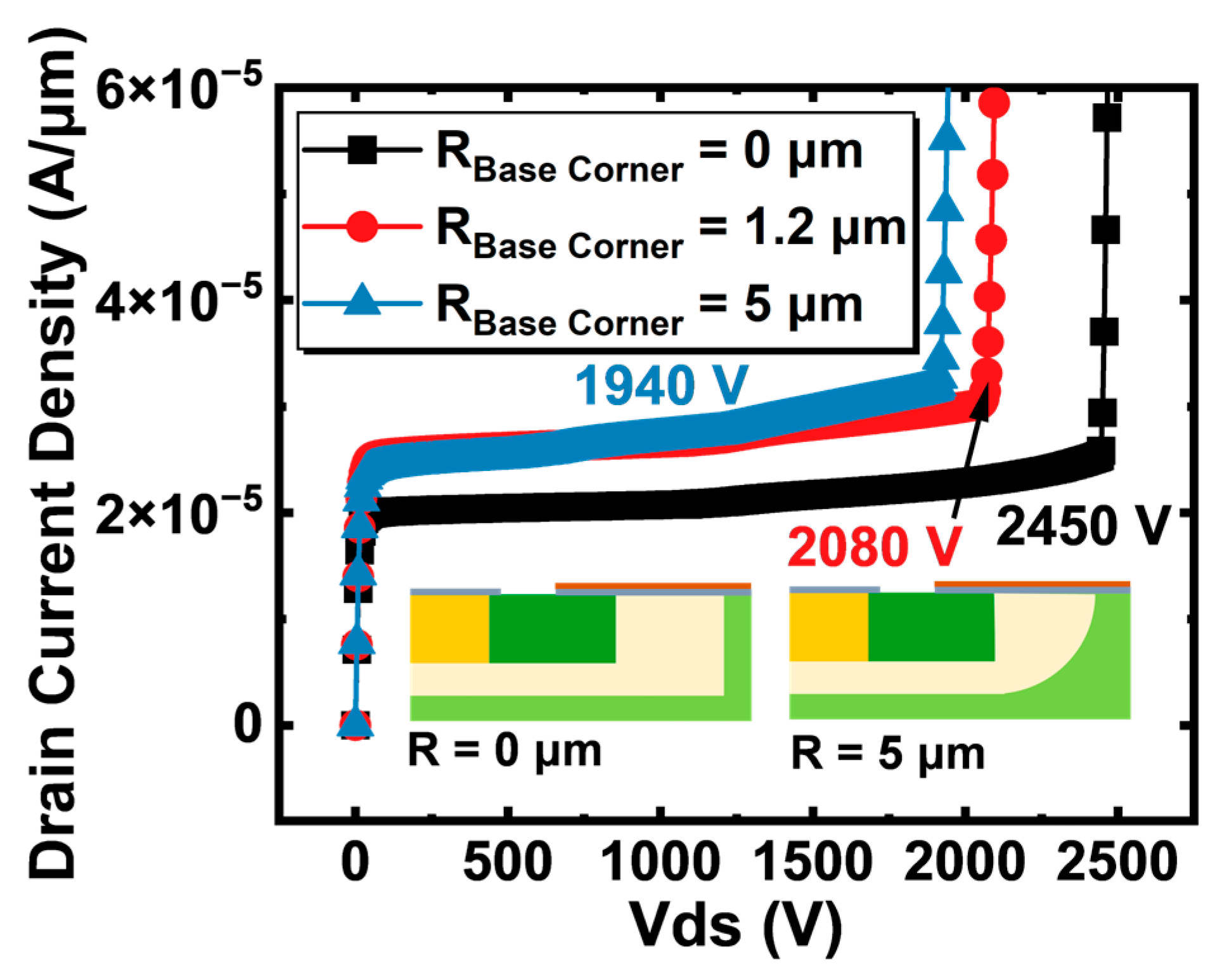




| Parameter | Value | Parameter | Value |
|---|---|---|---|
| Width of N+ Substrate (Wsub) | 40 μm | Width of P Base (WpBase) | 21 μm |
| Thickness of N+ Substrate (Tsub) | 5 μm | Thickness of P Base (TpBase) | 8 μm *, 5 μm # |
| N+ Substrate Dopant Concentration | 1 × 1019 cm−3 | P Base Dopant Concentration | 5 × 1016 cm−3 |
| Width of P+ Region (WP+) | 2 μm *, 6 μm # | Width of N Drift (WnDrift) | 40 μm |
| Thickness of P+ Region (TP+) | 3 μm | Thickness of N Drift (TnDrift) | 12 μm *, 15 μm # |
| P+ Region Dopant Concentration | 1 × 1019 cm−3 | N Drift Dopant Concentration | 3 × 1015 cm−3 |
| Width of N+ Region (WN+) | 13 μm *, 9 μm # | Width of Gate Oxide (Wox) | 27 μm |
| Thickness of N+ Region (TN+) | 3 μm | Thickness of Gate Oxide (Tox) | 0.03 μm |
| N+ Region Dopant Concentration | 1 × 1019 cm−3 | P Base Corner Radius | 6 μm *, 0–5 μm # |
| Parameter | Value |
|---|---|
| Bandgap at 300 K | 3.24 eV |
| Bandgap Narrowing Energy | 0.009 eV |
| AA,n/AA,p in Auger Recombination | 5 × 10−31 cm6s−1/2 × 10−31 cm6s−1 |
| BA,n/BA,p in Auger Recombination | 0.0 cm6s−1/0.0 cm6s−1 |
| CA,n/CA,p in Auger Recombination | 0.0 cm6s−1/0.0 cm6s−1 |
| H in Auger Recombination | 0.0/0.0 |
| N0 in Auger Recombination | 1 × 1018 cm−3/1 × 1018 cm−3 |
| E0 in Impact Ionization | 4 × 105 V/cm |
| ℏωop in Impact Ionization | 1 eV |
| a0n/a0p in Impact Ionization | 1.4686 × 106 cm−1/5.5222 × 106 cm−1 |
| b0n/b0p in Impact Ionization | 1.2075 × 107 V/cm/1.2724 × 107 V/cm |
| Temperature (K) | Vth (V) | SS (mV/dec) |
|---|---|---|
| 300 | 4.57 | 112.04 |
| 473 | 4.32 | 172.85 |
| 573 | 4.22 | 206.64 |
Disclaimer/Publisher’s Note: The statements, opinions and data contained in all publications are solely those of the individual author(s) and contributor(s) and not of MDPI and/or the editor(s). MDPI and/or the editor(s) disclaim responsibility for any injury to people or property resulting from any ideas, methods, instructions or products referred to in the content. |
© 2024 by the authors. Licensee MDPI, Basel, Switzerland. This article is an open access article distributed under the terms and conditions of the Creative Commons Attribution (CC BY) license (https://creativecommons.org/licenses/by/4.0/).
Share and Cite
Hu, Y.; Liu, F.; Liu, X. A Simulator for Investigation of Breakdown Characteristics of SiC MOSFETs. Appl. Sci. 2024, 14, 983. https://doi.org/10.3390/app14030983
Hu Y, Liu F, Liu X. A Simulator for Investigation of Breakdown Characteristics of SiC MOSFETs. Applied Sciences. 2024; 14(3):983. https://doi.org/10.3390/app14030983
Chicago/Turabian StyleHu, Yuanzhao, Fei Liu, and Xiaoyan Liu. 2024. "A Simulator for Investigation of Breakdown Characteristics of SiC MOSFETs" Applied Sciences 14, no. 3: 983. https://doi.org/10.3390/app14030983
APA StyleHu, Y., Liu, F., & Liu, X. (2024). A Simulator for Investigation of Breakdown Characteristics of SiC MOSFETs. Applied Sciences, 14(3), 983. https://doi.org/10.3390/app14030983








